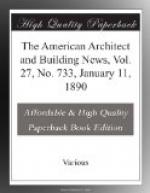Wherever the air that enwrapped the lifeless form of man or beast was dry, desiccation anticipated and prevented decomposition. In deserts, upon elevated plains, upon the slopes of lofty mountain ranges, to which the winds that passed their summits bore no moisture, the dead have not decayed, but have dried undecomposed. In the morgue attached to the Hospice of St. Bernard, the dead, lifted too late from their shroud of snow, and borne thither to await the recognition of their friends, dry, and do not decay. In the “Catacombs” of the monastery of the Capuchins at Palermo, and in the “Bleikeller” at Bremen, the same phenomenon has appeared. Even Egypt is a confirmation of these statements, for it is probable that, had much less care been taken to preserve the dead, they would not there have yielded to decay as in other lands; and that moisture is so far absent from the atmosphere that the dead would have been preserved from decay by desiccation had not embalming been resorted to. Upon the elevated Western plains of this continent, the bodies of beasts and men by thousands have been preserved from decomposition by desiccation. To take one instance out of many that might be cited: A cave was not long ago discovered high up among the Sierra Madre Mountains, within which were found, where they had rested undisturbed for many years, the lifeless figures of a little aboriginal household, dried and undecayed. Father, mother, son and daughter, one by one, as death had overtaken them, had been brought thither, bound so as to keep in death the attitude that had marked them when at their rest in life, and there they bore their silent but impressive witness to the beneficent action of the unmoist air that had stayed decay and kept them innocuous to the living that survived them. In Peru, instances of this simple, wholesome process abound on almost every side; upon the elevated plains and heights, as also beside the sea, the dead of Inca lineage, with the lowliest of their subjects, are found in uncounted numbers, testifying that in their death they did not injure the living, because desiccation saved them from decomposition; and a recent traveller has vividly described the scene that a battlefield of the late war presents, and that illustrates the same process, where, though years have passed since the last harsh sound of strife was heard, the fierce and bitter combatants still seem eager to rush to conflict or to sink reluctant into the embrace of death. And all these instances furnish conclusive proof that decomposition can be controlled, and that its loathsome and unwholesome transformations can be prevented, if only the simple conditions are secured that have already so extensively effected this result. That these conditions can be secured no one can doubt, for, every-day, in almost every clime, by processes familiar and available to man, the atmosphere has moisture added to it or taken from it; and the extraction of the moisture from a portion of the atmosphere is all that is required to introduce the process of Peruvian desiccation into the sepulchres of Chicago or New York.




